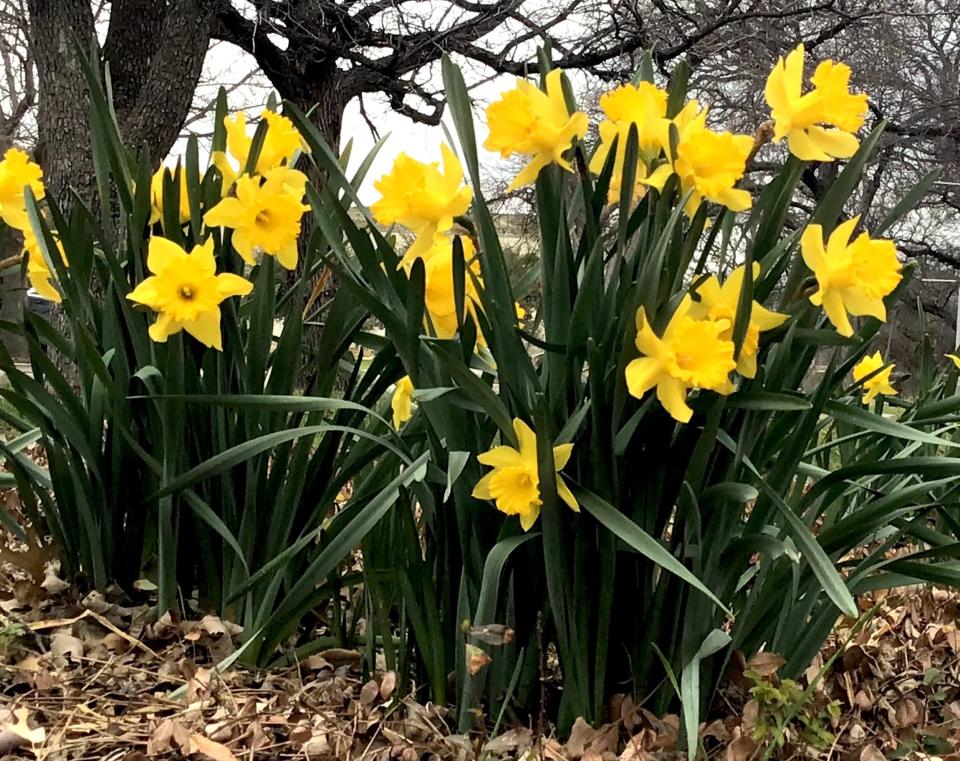Gardening for You: Daffodils inspire poetry
- Oops!Something went wrong.Please try again later.
A Welsh legend goes something like “the one who sees the season’s first daffodil will have blessings of wealth in the new year”. The English poet William Wordsworth (1770–1850) echoes the sentiment of the Welsh legend in his romantic poem “I Wandered Lonely as a Cloud”, more commonly known as "Daffodils" (poetryfoundation.org), one of the most famous poems in England.

Wordsworth was influential in leading the Romantic Age of English literature and in his powerful, 24-line poem he finds pleasure and comfort in nature.
"Daffodils" begins:
“I wandered lonely as a cloud
/ That floats on high o'er vales and hills,
/ When all at once I saw a crowd.
/ A host of golden daffodils. “ (1-4)
Further in the poem Wordsworth expresses:
“/I gazed-and gazed-but little thought
/What wealth the show to me had brought:” (18)
And he ends the poem with:
“/And then my heart with pleasure fills,
/And dances with the daffodils.” (23,24)
The simple splendor of clumps of blooming daffodils swaying in spring breezes do seem to dance like a golden cloud above the garden sending a wealth of pleasure.
Classic daffodils are solid yellow with a yellow corona, yellow perianth, yellow petals and sepals; sometimes all parts are white, but often a yellow corona is surrounded by white or cream petals and sepals. There are hundreds of daffodil varieties in dazzling combinations. Newer varieties come in tangerine, peach, and tinges of pink, and combinations like tangerine corona with white or cream petals and sepals.
Daffodils are often confused with jonquils. They are both members of the Amaryllidaceae family and both in the genus Narcissus (Nar-SIS-us). They are, however, distinct species; daffodil and jonquil are two of the 54 Narcissus species. Daffodil is Narcissus pseudonarcissus, meaning scented; jonquil, Narcissus jonquilla, from the Spanish name jonquillo, meaning slender leaves, derived from the Latin juncus, meaning rush-plant.
The two differ in their blooms. The daffodil has a single bloom, while the jonquil bloom is made of several flowers, usually smaller than the single flower of the daffodil. The single bloom of daffodil has two distinctive structures: a corona and a perianth tube. The corona is a trumpet-shaped cup surrounded by a perianth tube to which are attached three petals and three sepals.

Daffodils are one of the easiest and most reliable of the flowering spring bulbs. They are long-lived perennials and can be depended upon to multiply in number over the years. They easily form attention-grabbing clumps of color in the early spring since they bloom while landscapes are still drab and brown.
They make a good landscape choice in areas with deer, squirrel, cat and dog populations as animals are averse to daffodils. Stems, flowers, seed pods and bulbs contain alkaloids that are toxic to animals (plants.usda.gov).Join the dance and plant daffodils for next spring.
Ellen Peffley taught horticulture at the college level for 28 years, 25 of those at Texas Tech, during which time she developed two onion varieties. She is now the sole proprietor of From the Garden, a market garden farmette. You can email her at gardens@suddenlink.net
Suggested text for caption:
Clumps of golden daffodils make a showy early spring display. The single flowers with their golden yellow trumpet-shaped coronas and yellow perianths and petals cheerfully announce spring as they sway in the breeze.
This article originally appeared on Lubbock Avalanche-Journal: Gardening for You: Daffodils inspire poetry

